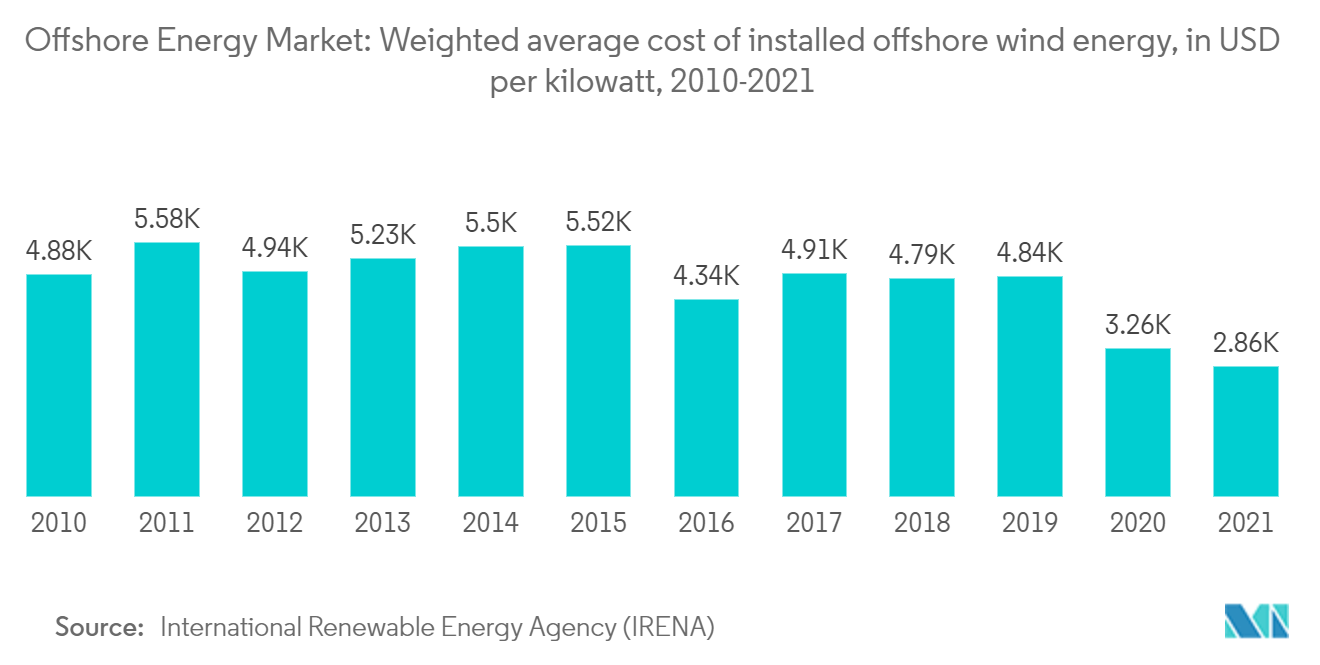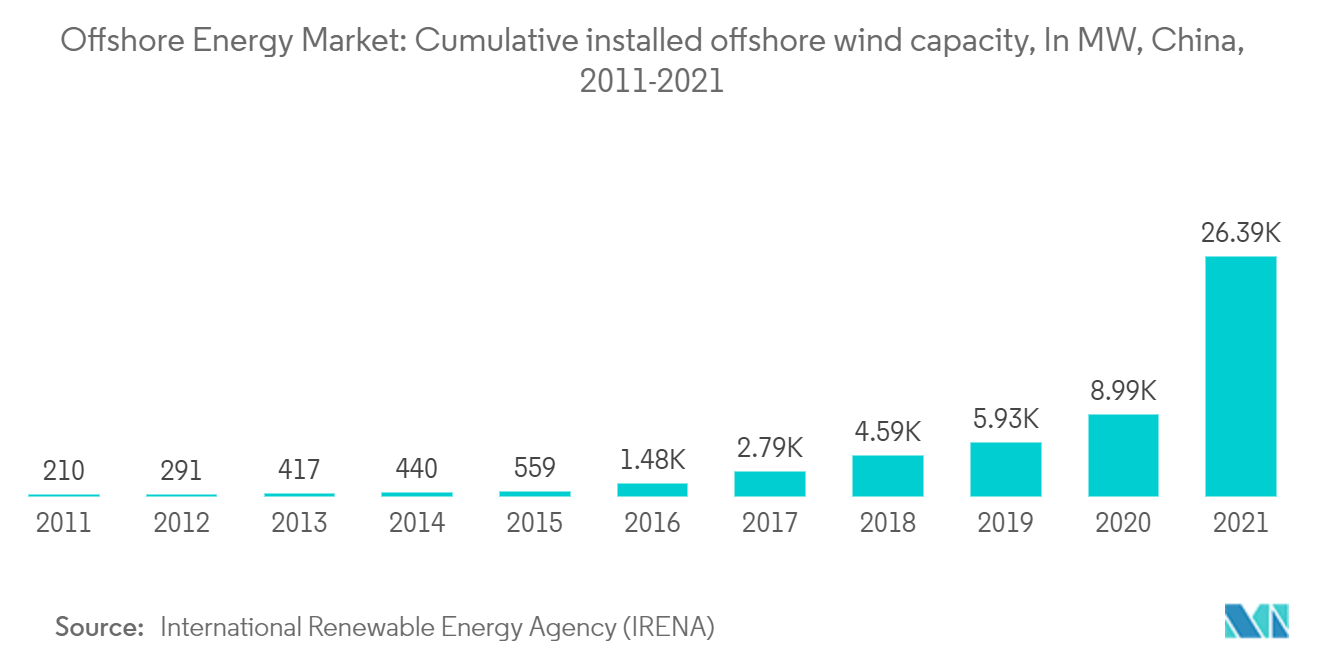Market Trends of Asia-Pacific Offshore Energy Industry
This section covers the major market trends shaping the APAC Offshore Energy Market according to our research experts:
Wind Energy Segment to Dominate the Market
- In the Asia Pacific region, wind energy is one of the most abundant energy resources, making it an ideal source for fulfilling its energy needs. In view of wind energy's tremendous growth potential, Asian countries, including China, India, Japan, and other regions, are currently focusing on implementing a widespread deployment of wind energy resources.
- As a result of an increasing focus on sustainable development and a commitment to reducing greenhouse gas emissions, offshore wind energy has become a popular source of energy. As a form of mainstream energy source for power generation, offshore wind energy has significantly changed from being a source of alternative energy. Offshore wind energy technology is being developed rapidly in Asian countries, which has contributed to the growing reliance on wind energy due to recent advancements in turbine technology and government incentives.
- In global offshore wind installations, China contributed 80% of that growth, a fourth year in which China has led the way. This growth was driven by a FiT cutoff at the beginning of 2022. In 2021, Vietnam became the third-largest market for offshore installations, with 779 MW of intertidal (nearshore) projects commissioned.
- According to the World Bank Group, the Philippines' EEZ has around 178 GW of technical resource potential for offshore wind, primarily floating wind, with 18 GW of fixed-bottom offshore wind. Considering that this is more than seven times the country's total installed electricity generation capacity, the opportunity to meet decarbonization and energy security goals is significant.
- The Philippine Department of Energy is developing an offshore wind roadmap in partnership with the World Bank Group's ESMAP-IFC Offshore Wind Development Program. A draft roadmap identifies six zones for offshore wind development, totaling 2.8 GW by 2030 and 58 GW by 2050, with mostly floating offshore wind projects.
- South Korea is committed to surging the share of renewable energy sources in the electricity supply, gradually phasing out coal and nuclear power from the energy mix. In December 2020, South Korea introduced its Ninth Basic Plan for Long-Term Electricity Demand and Supply 2020-2034 to increase the share of renewable energy in its energy mix from 15.1% in 2020 to 42% by 2034. Offshore wind energy is expected to play a vital role in reducing dependency on fuel imports for thermal power generation, thus supporting the offshore energy market in the coming years,
- In accordance with its Green New Deal, South Korea aims to generate 20% of its power from renewable sources by 2030. The country's offshore wind capacity is expected to increase by 12 GW, compared with its current capacity of 124.5 MW.
- In Australia, the solar energy market is expected to grow significantly owing to the country's increasing renewable investments and supportive state-level policies. For instance, the Electricity Infrastructure Roadmap of New South Wales (NSW) aims to construct 12 GW of new renewable projects, which include large-scale wind generations, attracting USD 21 billion in private investment by 2030. Similarly, Australia's Northern Territory continued to progress toward its target of 50% renewable energy by 2030.
- In 2021, Offshore Electricity Infrastructure Bill 2021 was introduced by the Australian government for the development of offshore wind energy. A number of offshore wind projects are likely to be proposed in the country as a result of the Bill, such as the Star of the South project in Victoria with 2.2 gigawatts (GW), Bass Offshore Wind in Tasmania, 1.5 GW Ninety Mile Beach in Victoria, Cliff Head Offshore Wind in West Australia, and Illawarra Offshore Wind in New South Wales, among others.
- The weighted average cost of installed offshore wind energy in 2021 was USD 2,858 per kilowatt, and the cost in 2010 was USD 4,876 per kilowatt. Declining costs for installing offshore wind energy are also driving the market growth.
- Considering these factors, the ongoing investments and developments in offshore wind in the different Asian-Pacific countries are expected to dominate the market during the forecast period.

China to Dominate the Market
- China has recognized that wind energy technology effectively provides electricity to rural and isolated areas. China's installed wind capacity has grown from a mere 4 MW in 1990 to 338.31 GW in 2021 due to policy reforms, dedicated R&D initiatives, new financing mechanisms, and clear goals in the most recent Five-Year Plans.
- According to IRENA, out of the total 19.89 GW of newly installed offshore capacity across the world, 87% (17.4 GW) of the new installations came from China in 2021, and the country's cumulative offshore wind capacity stood at 26.39 GW. This indicates that China is expected to be the world's largest offshore wind energy market.
- Various Chinese provinces have set different targets to increase offshore wind power. Owing to this, Guangdong intends to build 30 GW of offshore wind power by 2030, followed by Jiangsu (15 GW), Zhejiang (6.5 GW), and Fujian (5 GW). Other provinces have also set their own targets and developed offshore wind development plans. Thus, such initiatives by the Chinese provinces are likely to drive the offshore wind energy sector during the forecast period.
- In December 2021, China's largest offshore wind farm was connected to the grid at full capacity. The Jiangsu Qidongoffshore wind farm has a capacity of 802 MW and is located off the eastern province of Jiangsu. The project covers an area of 44.2 square miles (114.5 square kilometers) and consists of 134 wind turbines and was built at the cost of USD 2.2 billion and is owned by Jiangsu Huawei Wind Power and QidongHua Er Rui Wind Power Technology.
- In February 2022, MingyangSmart Energy, a Chinese wind turbine manufacturer, announced that the company would deploy two wind turbines with 16 MW each in the South China Sea. The wind farm is expected to come online in 2026, and the two 16 MW turbines being installed may join the 59 8-MW wind turbines of the wind farm. MingyangSmart Energy's MySE16.0-242 is 242 meter tall and is the world's largest turbine.
- In January 2022, Hann-Ocean Energy launched its first third-generation 15-kilowatt wave energy converter (WEC) in the Shengsi archipelago, China, and is entering a one-year sea trial, with the device expected to generate 70,000 kWh of power annually.
- Overall, offshore energy in China is expected to grow during the forecast period due to supportive public and private initiatives and an increasing number of offshore wind and wave energy projects.

